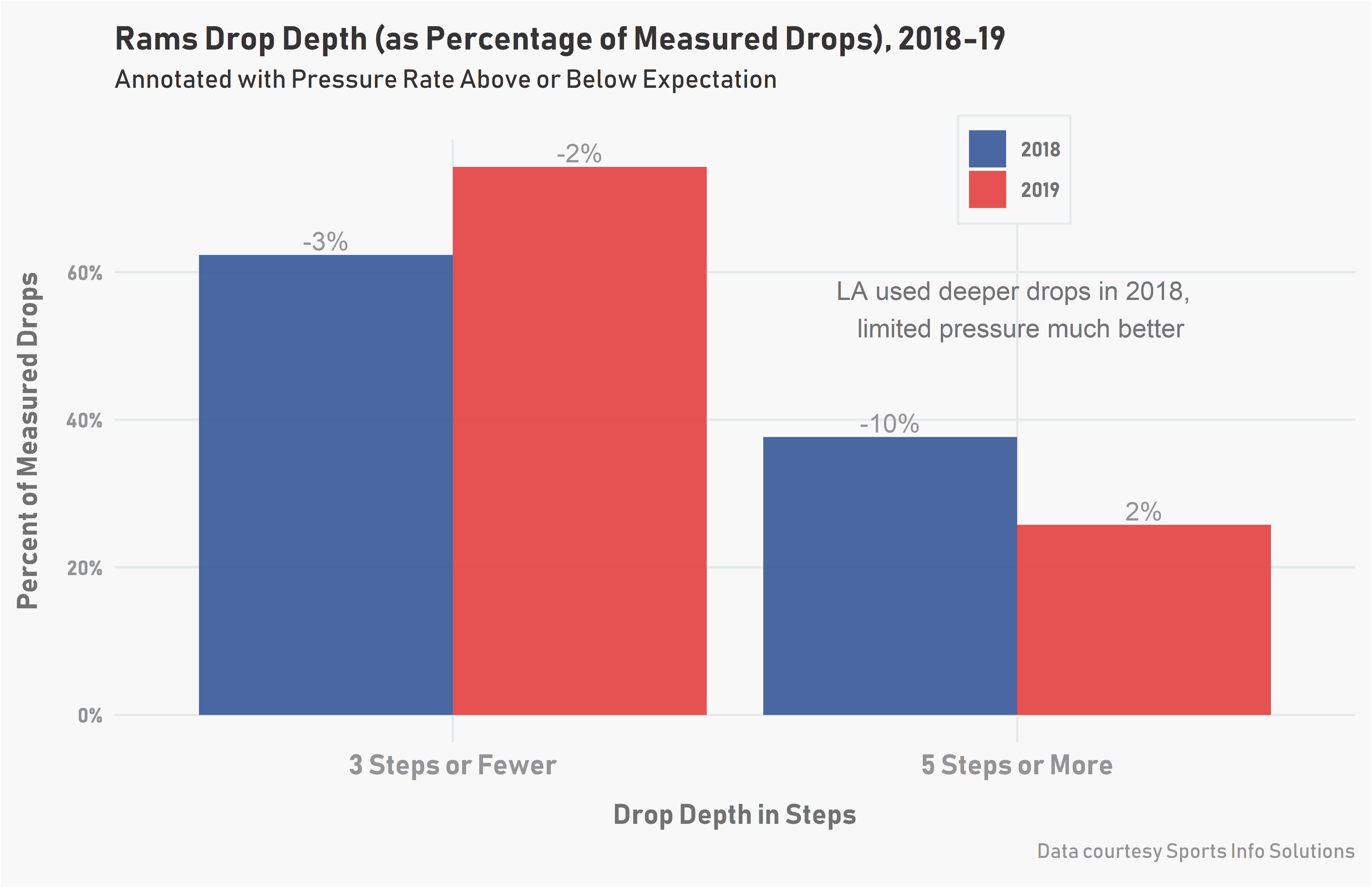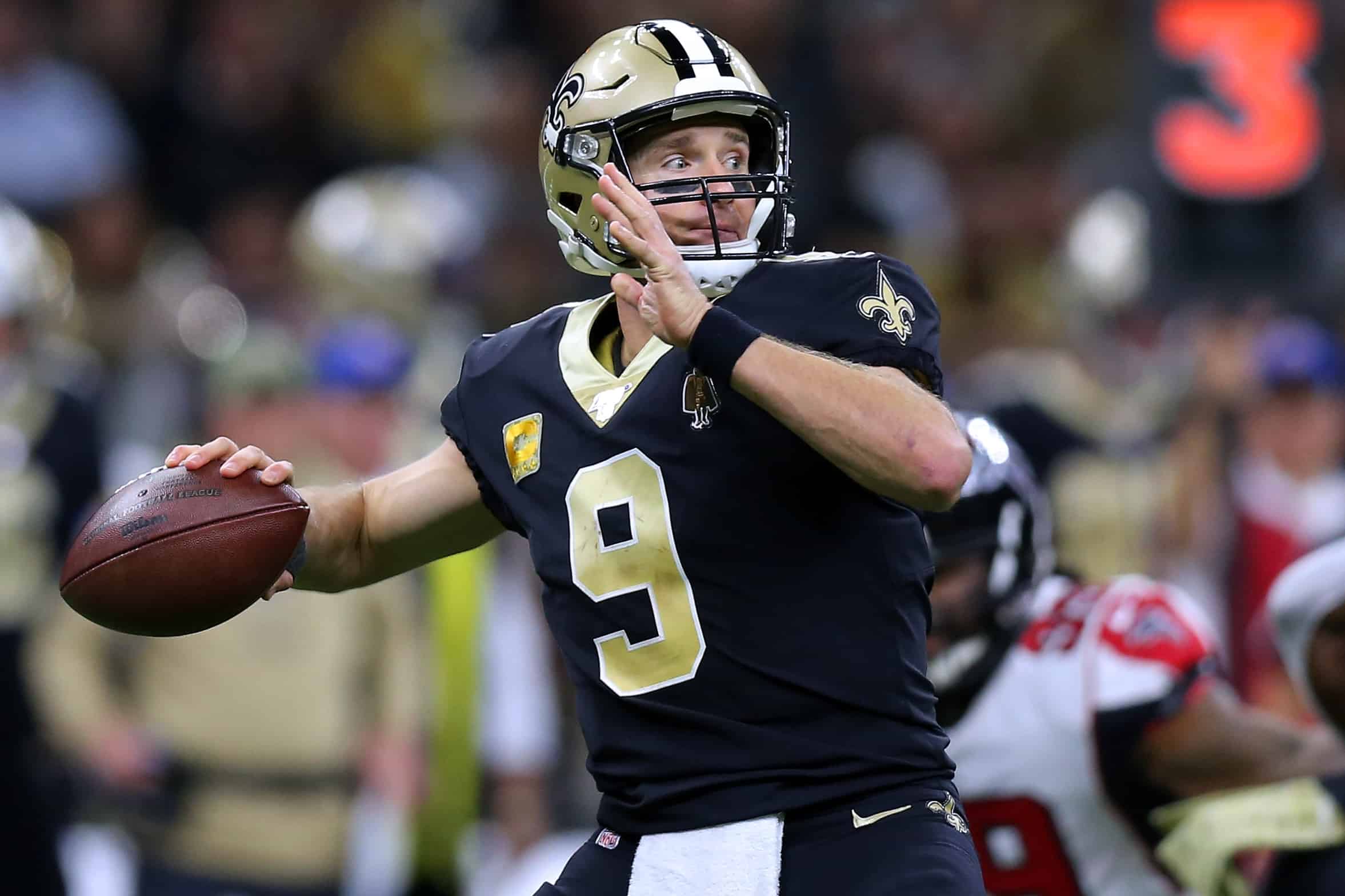While watching a game, most of us are at least peripherally aware of the effect that a play’s design has on the outcome. Obviously, there are many facets to that, but one that has an almost immediate impact is the depth of a quarterback’s drop. Typically we think of this in terms of one-, three-, five-, or seven-step drops, plus things like designed rollouts or running back screens.
We intuitively understand the effect that a quick-hitting or slow-developing play design can have on a quarterback’s success, but often we don’t operationalize that understanding when reviewing a player’s statistical profile. Sports Info Solutions (SIS) started charting drop depths in 2018, which allows us to dig into this.
Splits by Drop Depth
SIS charts eleven different drop types, but this discussion will mostly focus on dropbacks of defined depths because it’s a much cleaner comparison. Rollouts, screens, and RPOs will get bundled in later as appropriate.
On average, teams like to throw deeper from deeper drops; this should seem obvious. The average throw depth of a quick-hitter is less than one-third the depth of the average throw from a seven-step drop.
Average Throw Depth by Drop Type, 2018-19
| Drop Depth | Under Center | Shotgun |
|---|---|---|
| 0/1 Step | 3.2 | 4.9 |
| 3 Step | 8.3 | 9.4 |
| 5 Step | 11.5 | 12.3 |
| 7 Step | 13.3 | 15.1 |
With those deeper route concepts comes a greater risk of pressure on the quarterback. The pressure rate on deep drops is more than double that of one-step drops.
Pressure Rate by Drop Type, 2018-19
| Drop Depth | Under Center | Shotgun |
|---|---|---|
| 0/1 Step | 15% | 21% |
| 3 Step | 30% | 38% |
| 5 Step | 40% | 46% |
| 7 Step | 43% | 45% |
Comparing Actual Performance to Expected Performance
Pressure Rate
We can contextualize a player’s stat line by comparing his pressure rate, average throw depth, etc. to the average of players with his distribution of drop types. For pressure rate, for example, we compare the actual pressure rate to the expected pressure rate based on each play’s drop type.
Quarterbacks who are asked to make shorter drops should be expected to face less pressure and make shorter throws, and the opposite would be true of those with a lot of deep drops. For this section, we’ll use all pass plays, not just the simple 1/3/5/7 step drops.
Pressure Rate Above or Below Expectation, 2018-19 (min. 200 attempts)
| Player | Actual | Expected | (+/-) |
|---|---|---|---|
| Daniel Jones | 43% | 34% | 9% |
| Deshaun Watson | 43% | 34% | 9% |
| Russell Wilson | 40% | 32% | 8% |
| Josh Rosen | 41% | 34% | 7% |
| Nick Mullens | 36% | 31% | 5% |
| Andy Dalton | 29% | 34% | -5% |
| Jimmy Garoppolo | 27% | 33% | -6% |
| Ben Roethlisberger | 25% | 32% | -7% |
| Tom Brady | 26% | 34% | -8% |
| Drew Brees | 27% | 37% | -10% |
Daniel Jones played primarily in a quick-hitting offense while at Duke, and it made sense for the Giants to give him similar looks in his rookie season given the team’s receiving corps. However, the combination of Jones’s willingness to move around and the failings of New York’s offensive line have led him to be under pressure substantially more than we’d expect.
It’s important to acknowledge Jones’s contributions to his pressure situation. Quarterbacks with greater mobility tend to maintain high pressure rates because their confidence in being able to escape pressure can lead them to hold the ball longer. It’s rather convincing to see Deshaun Watson and Russell Wilson at the top of the list and three aging and immobile signal-callers at the bottom.
Throw Depth
Taking the same strategy, we can use average throw depth to see how aggressive a quarterback is compared to others with his drop distribution. This gives us a quick-and-dirty measure of the tendency of the quarterback to push the ball downfield.
Average Throw Depth Above or Below Expectation, 2018-19 (min. 200 attempts)
| Player | Actual | Expected | (+/-) |
|---|---|---|---|
| Josh Allen | 10.1 | 7.7 | 2.4 |
| Jameis Winston | 10.5 | 8.4 | 2.1 |
| Patrick Mahomes | 9.1 | 7.5 | 1.6 |
| Lamar Jackson | 8.7 | 7.4 | 1.3 |
| Russell Wilson | 8.9 | 7.6 | 1.3 |
| Derek Carr | 6.8 | 8.1 | -1.3 |
| Jacoby Brissett | 7.4 | 8.8 | -1.4 |
| Blake Bortles | 7 | 9 | -2 |
| Drew Brees | 6.9 | 9.3 | -2.4 |
| Teddy Bridgewater | 6.2 | 8.6 | -2.4 |
Any downfield aggression leaderboard that has Josh Allen and Jameis Winston at the top and Drew Brees and Teddy Bridgewater at the bottom comfortably passes the smell test. The most interesting name on this list to me is Lamar Jackson, whose drop distribution suggests an average throw depth that would be toward the bottom of the league (ahead of only Kyler Murray and the two 2018 Eagles quarterbacks, Nick Foles and Carson Wentz). Jackson’s willingness to push the ball downfield (especially this year with Marquise Brown in the fold) makes for a real conundrum for opponents defending him.
Case Study: The Los Angeles Rams
Last season, the Rams had a prolific offense that was revolutionary to some extent for its consistency in its looks. They used 11 personnel almost exclusively, ran a lot of plays from tight splits (i.e. with receivers close to the formation as opposed to out wide), and called almost all of their designed runs from under center. Another superlative that the Rams held in that season was Most Likely to Use a Seven-Step Drop.
In 2018, the Rams led the league by a mile in seven-step dropbacks. They almost always involved a play-action fake, and that allowed the receivers to wreak havoc in the intermediate regions of the field as opposing linebackers got sucked up.
That’s all well and good when the offensive line can hold down the fort that whole time, but the Rams’ front has had well-documented struggles this year, and Sean McVay is pivoting away from deep drops.

In 2018, the plan worked because quarterback Jared Goff often found himself in a position where he had taken a deep drop and he didn’t have guys immediately bearing down on him. He had the eighth-most clean-pocket attempts in the NFL, and his clean-pocket throws produced a positive Expected Points Added 59% of the time, which was third among passers with at least 50 clean-pocket attempts.
This season, he’s still getting clean-pocket opportunities because of the shorter drops, but a) they’re less valuable opportunities on average, and b) he has been quite poor in those spots. Goff’s 87.9 clean-pocket Independent Quarterback Rating (IQR, Sports Info Solutions’ modified Passer Rating that removes non-competitive throws and accounts for drops) is worse than any other quarterback with at least 100 attempts from a clean pocket in 2019. When you combine more pressured attempts with worse performance when not pressured, it’s not a surprise that the Rams have fallen off from elite to average.
















